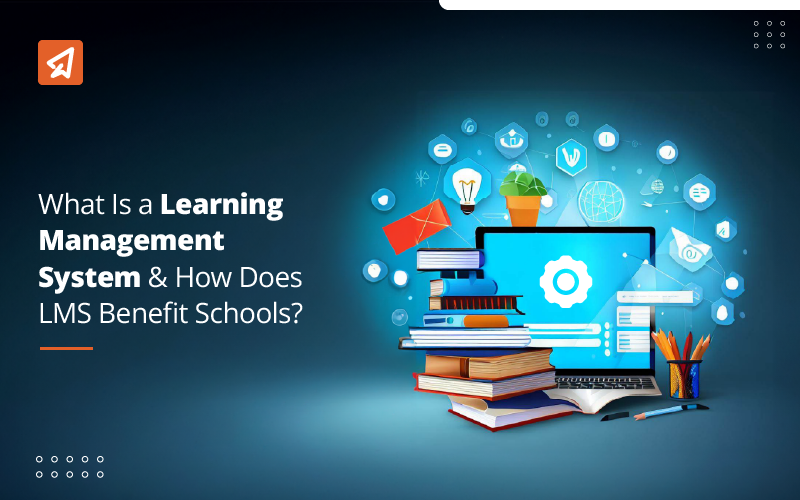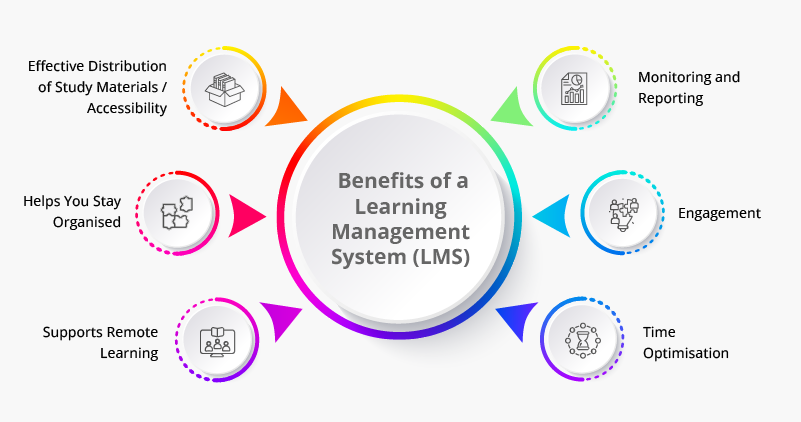What Is a Learning Management System (LMS) & How Does LMS Benefit Schools?

To make learning new things easier and speed up how we deliver well-organised training, companies should think about using an LMS. If you’re thinking about using one, you’ll probably want to find out what good things come with a Learning Management System.
An LMS is like a software tool that helps manage and deliver educational courses and training programs. It keeps track of everything from organising courses to documenting progress. Understanding the perks of an LMS is crucial for making the right decision for your organisation’s training needs.
In this blog, we’ll examine what is LMS in education and how LMS works in detail. So, without further ado, let’s get started!
What Is a Learning Management System (LMS)?
Understanding what a learning management system (LMS) is can be important for many people who are curious about educational software. An LMS is essentially software created to organise and enhance learning experiences. It serves as a comprehensive platform where educators can upload course materials, and students can access them through their individual accounts.
The versatility of an LMS extends to supporting both traditional in-person instruction and virtual classes. Beyond content delivery, LMS for students enables seamless communication, progress tracking, and comprehensive record-keeping of essential student data. Designed to enhance instructor efficiency, the LMS is equally attuned to meeting the diverse needs of learners. In essence, it functions as a collaborative tool that benefits all participants in the educational process.
What Is the Use of a Learning Management System in Schools?
Similar to online libraries, Learning Management Systems (LMS) function as digital hubs for educational institutions, especially schools. These platforms excel in knowledge management, streamlining the collection, organisation, access, and analysis of valuable school resources, documents, and staff expertise. Notably, the precise function of the LMS adapts to each school’s unique training approach and educational goals.
What Are the Benefits of a Learning Management System (LMS) in Education?

- Effective Distribution of Study Materials / Accessibility
The vast availability of educational materials online empowers learners and educators in new ways. Students and employees can now access valuable resources and pursue knowledge on their own terms, regardless of location or schedule. This fosters independent learning at a personalised pace, catering to busy individuals, self-directed learners, and those working remotely.
Educators, too, benefit from online platforms as they can easily grant access to diverse study materials with a single click, eliminating the need for time-consuming and costly printing of paper copies. Furthermore, the benefits of LMS for schools include the ability to effortlessly update online resources, saving schools substantial resources and eliminating the burden of reprinting outdated materials. This shift to online learning empowers both students and educators with greater flexibility, convenience, and cost-effectiveness.
- Helps You Stay Organised
Imagine ditching scattered files and endless links! An LMS centralises everything, allowing teachers to build organised courses with dedicated modules and folders for each topic. This digital filing cabinet empowers them to incorporate various methods like storytelling, blended learning, and gamification, all within the platform. Embedding videos and external links directly eliminates the need for individual sharing, streamlining the learning experience. And the best part? No more starting from scratch – the LMS securely stores everything, ensuring seamless reuse and continued course development.
- Supports Remote Learning
A major benefit of LMS is its ability to seamlessly transition to remote learning environments. During the pandemic, when schools were forced to close, LMS facilitated continued education for millions. With all course materials online, students could access them from anywhere, anytime. Additionally, LMS allows teachers to upload recorded lectures, replicating the classroom experience even when students are remote. Furthermore, teachers can easily update and expand online content, ensuring it stays relevant and reflects the evolving needs of the education sector. These capabilities make LMS a valuable tool for both teachers and students in various learning environments.
- Engagement
Interactive features like quizzes, knowledge checks, discussion forums, and multimedia elements breathe life into the learning experience, fostering engagement and boosting knowledge retention. LMS platforms go beyond that, fostering collaboration and communication between learners, instructors, and managers, fostering a dynamic learning experience where everyone can contribute and learn from each other.
- Monitoring and Reporting
Imagine having a smart assistant that keeps track of everything in your classroom! An LMS is like that helpful assistant, letting you see how each student is doing in every subject, their past performance, and even their participation in extracurricular activities. This lets you identify students who might need a little extra help and provide them with special resources or guidance. Similarly, for students who are excelling, you can offer them advanced challenges to further sharpen their skills. The LMS also helps you analyse the entire class, showing areas where the teaching material might need adjustments.
But that’s not all. An LMS can also track how much time students spend on assignments, which learning materials they use most, and for how long. This helps teachers understand how engaged students are and identify areas where the course material might need improvement.
- Time Optimisation
Streamlining workflows and promoting organisation, Learning Management Systems (LMS) for schools centralise all course materials and assignments in one platform. Students can easily access deadlines and course requirements, allowing them to stay on track and submit work on time.
Instructors benefit from a streamlined submission process, enabling them to effortlessly track progress, identify students needing help, and ensure everyone meets deadlines. Furthermore, the LMS acts as a secure archive of coursework and grades, eliminating the need for scattered physical documents and simplifying record-keeping for both students and teachers.
LMS Challenges and Solutions for Teachers
- Navigating New Tech: While new learning platforms can bring exciting possibilities, educators unfamiliar with technology may face a steeper learning curve.
Solution: To ease the transition, schools can offer in-depth training tailored to the specific learning management system (LMS) used, along with ongoing support from IT professionals or tech-savvy colleagues.
- Content Creation and Curation: Making interesting and helpful online content can be hard and takes a lot of time.
Solution: Teachers should work together and share their best ideas, materials, and content they’ve already made. Also, they can use online resources that have really good educational materials.
- Assessment and Feedback: Checking how well students are doing and giving feedback in an online class can be trickier than in a regular class.
Solution: Teachers can use the tools in the online learning system to create different kinds of tests, discussions, and interactive assignments. It’s important to give feedback to students quickly and make it personal to help them learn better.
- Technical Difficulties and Support: Sometimes, problems with the learning system or students’ devices can be a real headache and disrupt learning. Not having enough help for these tech issues can make things even more frustrating.
Solution: Make a clear way for reporting tech problems, and have IT staff ready to help quickly. Also, create easy-to-find guides for fixing common problems.
- Student Engagement and Motivation: Getting students to stay interested and excited about learning online can be tough, especially for those who like being in a classroom.
Solution: Make lessons more interesting by using tools that get students involved, adding fun elements like games, and talking to them regularly through announcements, discussions, or video chats. It keeps them interested and motivated to learn.
- Data Overload and Interpretation: Having too much data from a Learning Management System (LMS) can be a lot for teachers to handle. They need good skills to understand and use all that information in a helpful way.
Solution: Give training on how to understand LMS data and use analytics to make teaching better. Create a dashboard that’s easy to use and shows the most important information for keeping track of progress.
Maximize the impact of your LMS by pairing it with interactive Smart Classroom Activities that enrich learning.

Boost Student Engagement With Curated Activities for Your Classroom!
✓ 60+ activities across 6 different engagement categories
✓ Designed for grades 3 to 12 and easy to plug into any lesson plan
✓ Comes with printable cards and step-by-step instructions
Closing Thoughts
Learning Management Systems (LMS) are not simply tools; they represent a paradigm shift in education, offering accessibility and engaging learning experiences. With LMS for education, the possibilities are endless, and the journey to knowledge is smoother than ever. So, let’s embrace the future of learning, one click at a time.
Tired of Outdated Learning Methods?
Extramarks can revolutionise your institution with engaging resources.
Explore now!Last Updated on April 8, 2025
Reviewed by

Priya Kapoor | AVP - Academics
Priya Kapoor is an accomplished education professional with over 18 years of experience across diverse fields, including eLearning, digital and print publishing, instructional design, and content strategy. As the AVP – Academics at Extramarks, she leads academic teams in creating tailored educational solutions, ensuring alignment with varied curricula across national and international platforms...read more.










